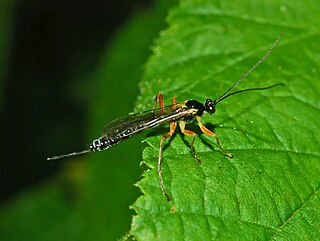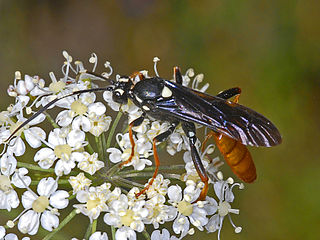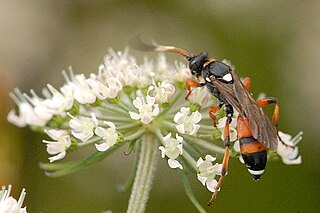
The superfamily Ichneumonoidea contains one extinct and three extant families, including the two largest families within Hymenoptera: Ichneumonidae and Braconidae. The group is thought to contain as many as 100,000 species, many of which have not yet been described. Like other parasitoid wasps, they were long placed in the "Parasitica", variously considered as an infraorder or an unranked clade, now known to be paraphyletic.

The Ichneumonidae, also known as ichneumon wasps, ichneumonid wasps, ichneumonids, or Darwin wasps, are a family of parasitoid wasps of the insect order Hymenoptera. They are one of the most diverse groups within the Hymenoptera with roughly 25,000 species currently described. However, this likely represents less than a quarter of their true richness as reliable estimates are lacking, along with much of the most basic knowledge about their ecology, distribution, and evolution. It is estimated that there are more species in this family than there are species of birds and mammals combined. Ichneumonid wasps, with very few exceptions, attack the immature stages of holometabolous insects and spiders, eventually killing their hosts. They thus fulfill an important role as regulators of insect populations, both in natural and semi-natural systems, making them promising agents for biological control.

The Braconidae are a family of parasitoid wasps. After the closely related Ichneumonidae, braconids make up the second-largest family in the order Hymenoptera, with about 17,000 recognized species and many thousands more undescribed. One analysis estimated a total between 30,000 and 50,000, and another provided a narrower estimate between 42,000 and 43,000 species.

Ichneumon insidiosus is a species belonging to the family Ichneumonidae subfamily Ichneumoninae. It was first described by Constantin Wesmael in 1844.

Polysphincta boops is a species belonging to the family Ichneumonidae subfamily Pimplinae.

Hemipenthes morio is a species of 'bee flies' belonging to the family Bombyliidae subfamily Anthracinae.

Pimpla are a worldwide genus of the parasitic wasp family Ichneumonidae.

Amblyjoppa fuscipennis is a species of the parasitic wasp in the family Ichneumonidae. It was first described by Constantin Wesmael in 1844.

Coelichneumon cyaniventris is a species of wasp belonging to the family Ichneumonidae. The species was first described by Constantin Wesmael in 1859.

Anomalon is a large genus of parasitoid wasps belonging to the family Ichneumonidae. This may be the only genus in the tribe Anomalonini, although Neogreeneia Viereck, 1912 is sometimes considered a valid genus of the tribe.
Habronyx minutus is a species of small parasitic wasp in the subfamily Anomaloninae of family Ichneumonidae. It has a length of 5.5 to 8 millimetres. The species was described by D. F. Ward in 2015, and the holotype was collected in December 1980 at Pelorus Bridge.

Ichneumon sarcitorius is a species of wasp belonging to the family Ichneumonidae subfamily Ichneumoninae.

Meringopus calescens is a species of wasp belonging to the family Ichneumonidae first described by Johann Ludwig Christian Gravenhorst in 1829.

Leucospis dorsigera is a species of wasp belonging to the family Leucospidae.

Pimpla rufipes, the black slip wasp, is a species of wasp belonging to the family Ichneumonidae. It is distributed across Europe, Asia, and northern Africa.
Dusona aemula is a species of parasitic wasp belonging to the family Ichneumonidae, subfamily Campopleginae. It is a parasitoid of Geometrid moth larvae, mainly Eupithecia species.
Dusona juvenilis is a species of parasitic wasp belonging to the family Ichneumonidae, subfamily Campopleginae. It is a parasitoid of Eupithecia haworthiata larvae.

Dusona leptogaster is a species of parasitic wasp belonging to the family Ichneumonidae, subfamily Campopleginae. It is a parasitoid of Geometrid moth larvae, the two known hosts being Alsophila aescularia and Lomaspilis marginata.
Dusona nidulator is a species of parasitic wasp belonging to the family Ichneumonidae, subfamily Campopleginae. It is a parasitoid, but the host is unknown.














